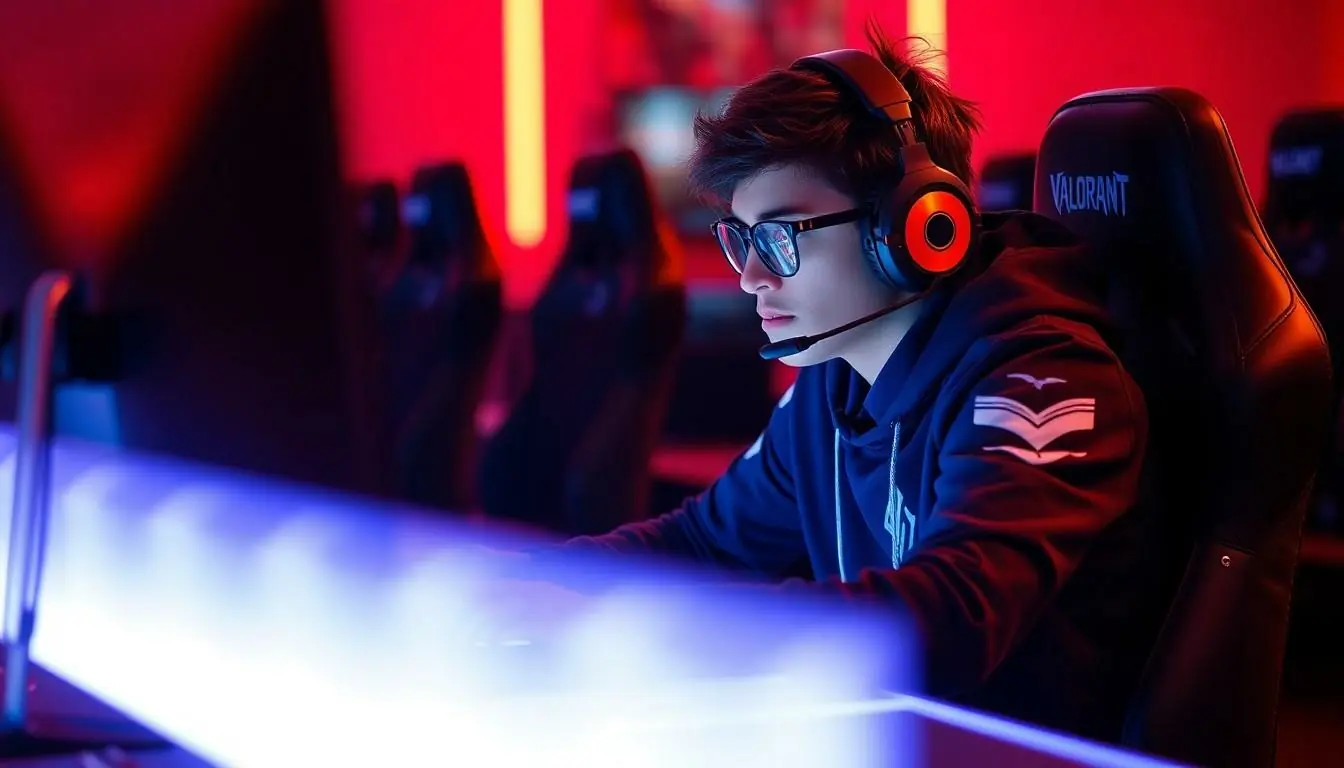Table of Contents
ToggleIn the world of Valorant, climbing the ranked ladder is like trying to scale a mountain made of ice—slippery, challenging, and full of surprises. Players often find themselves asking, “How does this ranking system even work?” Understanding the ins and outs of Valorant’s ranked mode isn’t just helpful; it’s essential for anyone serious about improving their game and showing off those shiny ranks.
Overview of Valorant Ranked
Valorant’s ranked mode operates on a clear system that determines player skill and performance. Players must first complete a series of placement matches, typically consisting of five games, to establish their initial rank. Ranking tiers range from Iron, Bronze, and Silver to Gold, Platinum, and beyond, culminating in Radiant as the highest rank.
Each rank has three divisions, and players earn or lose ranks based on match outcomes. Winning matches leads to rank progression, while losing results in rank demotion. Performance metrics, such as kills, deaths, assists, and objective plays, play a critical role in determining rank adjustments.
Players experience rank decay if they remain inactive for extended periods, enforcing the necessity for consistent gameplay. Matchmaking strives to pair players against opponents of similar skill levels, enhancing the competitive experience. Competitive integrity is maintained by accounting for factors like party sizes, ensuring fair matches in team compositions.
A unique feature includes the use of ranks for both individuals and teams, allowing for a comprehensive assessment of personal and group performance. Players can monitor their rankings through the in-game client, where the leaderboard displays their progress and stats. Accurate evaluation of a player’s skill comes from understanding both individual contributions and overall team dynamics during matches.
Valorant encourages players to analyze their gameplay strategically, focusing not just on winning but on improving skills to climb the ranks. The ranking system promotes a continuous growth mindset, pushing players toward higher levels of competitive play. Engage with other players, learn from experiences, and refine skills to excel in the challenging world of Valorant ranked mode.
Ranking System Explained
Valorant’s ranking system is structured to enhance competitive gameplay. Understanding the intricacies of rank tiers and placement matches is crucial for players aiming to climb the ranks.
Rank Tiers and Divisions
Valorant features a total of eight rank tiers. These include Iron, Bronze, Silver, Gold, Platinum, Diamond, Immortal, and Radiant. Each rank contains three divisions, which serve to further distinguish player skill levels. For instance, a player in Gold 1 ranks higher than someone in Gold 3. Earning rank changes occurs through match outcomes, but performance metrics such as kills, assists, and objectives also factor into adjustments. Consistent gameplay remains vital since inactive players might experience rank decay.
Placement Matches
Placement matches initiate a player’s ranked journey in Valorant. Completing five placement matches determines their starting rank. Players may receive variable ranks based on individual performances during these matches. Outstanding gameplay can yield a higher initial rank, while poor results may place a player lower than anticipated. Flexibility in rank assignment means players can easily find their appropriate skill level. Understanding personal strengths during these matches helps set realistic expectations for future ranking progression.
Matchmaking Characteristics
Valorant’s ranked mode features distinct matchmaking characteristics that ensure fair competition. These characteristics foster a balanced environment where players can improve and showcase their skills.
Competitive Integrity
Competitive integrity remains a core principle of Valorant’s matchmaking. Players of similar skill levels face off against one another, preventing extreme mismatches that could lead to frustrating experiences. The system evaluates performance metrics such as kills, assists, and objectives completed during a match. By prioritizing skill and performance, it aims to create high-stakes games where players can develop teamwork and strategy.
Skill-Based Matchmaking
Skill-based matchmaking plays a crucial role in the ranked experience. The algorithm utilizes players’ ranks, previous match outcomes, and overall performance to pair opponents effectively. While attempting to win matches, players encounter various strategies and playstyles, providing valuable learning opportunities. In addition, the system adjusts rankings based on recent performance, ensuring that those who consistently excel receive fair recognition for their efforts. This approach not only aids in personal growth but also enhances the overall enjoyment of the competitive landscape.
Strategies to Improve Your Rank
Improving rank in Valorant relies on several effective strategies. Players must focus on communication and team play as essential components.
Communication and Team Play
Effective communication drastically enhances team performance. Players should consistently share information about enemy positions and strategies. Using voice chat or the game’s ping system promotes better coordination. Demonstrating teamwork leads to better outcomes in matches. Encouraging teammates, regardless of rank, fosters a positive atmosphere. Adapting to team dynamics allows for better synergy in executing strategies. Lastly, coordinating tactics enhances the likelihood of winning rounds.
Individual Skill Development
Individual skill development remains paramount in climbing ranks. Practicing aim through aim trainers or the game’s practice range drastically improves precision. Understanding agent abilities plays a critical role in maximizing effectiveness in matches. Additionally, reviewing gameplay recordings helps identify strengths and weaknesses. Setting specific goals assists players in tracking their progress. Engaging with community resources, like tutorials and guides, offers invaluable insights. Seeking consistent feedback from peers accelerates personal growth, leading to improved overall performance.
Common Misconceptions About Ranked
Many players misunderstand the impact of performance on ranking. Winning matches certainly helps, but individual contributions like kills and assists play an essential role in rank adjustments. Players might think that rank solely reflects match victories, neglecting the importance of contribution to overall team dynamics.
Another common misconception revolves around placement matches. Some believe that five initial matches determine their permanent rank. Instead, these matches provide a starting point that can shift significantly based on subsequent performance. Exceptional placements can lead to higher initial ranks, while underwhelming results may affect future games.
Rank decay presents additional confusion for players. Individuals might think that inactivity won’t affect their rank, but it can lead to a decline after a specified period. Consequently, consistent gameplay is vital for maintaining one’s standing.
Players often assume the matchmaking system guarantees equal skill levels among teams. While it strives for balance, disparities can still occur based on player pools and match timing. A deeper understanding of the algorithm can help players navigate these situations better.
Lastly, many players overlook the significance of teamwork. Some see ranked play as a solely individual endeavor. High ranks require collaboration and communication, so players must invest in team strategies and adapt to group dynamics to achieve success. Emphasizing these aspects leads to better match outcomes and enhances the overall ranked experience.
Conclusion
Understanding how Valorant’s ranked system operates is essential for players aiming to climb the competitive ladder. By recognizing the importance of placement matches and the impact of individual performance, players can set realistic goals for their ranking journey. Consistent gameplay and effective communication with teammates play crucial roles in achieving success.
Players should also remain aware of the dynamic nature of ranks and the potential for rank decay due to inactivity. Embracing a strategic approach to gameplay while focusing on skill development will not only enhance personal performance but also contribute to a more rewarding experience in Valorant’s ranked mode. With dedication and the right mindset, players can navigate the challenges of ranked play and achieve their desired ranks.






